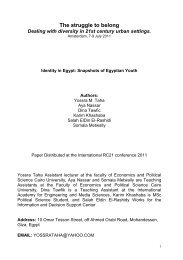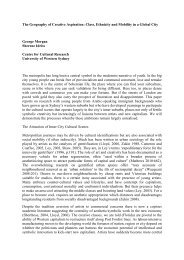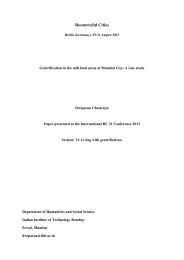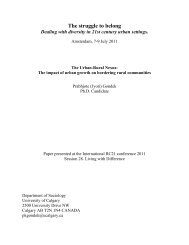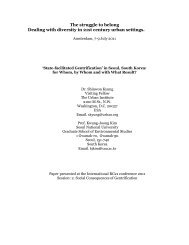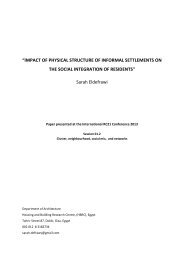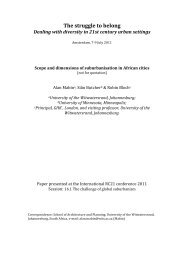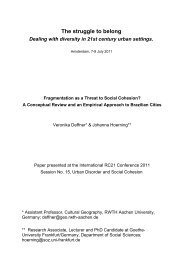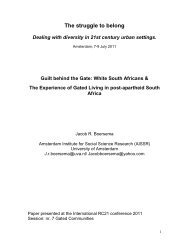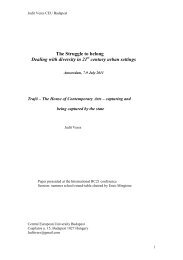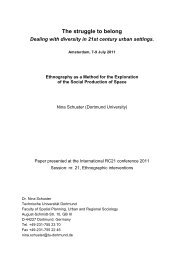The hidden side of metropolization. Governing squats and slums in ...
The hidden side of metropolization. Governing squats and slums in ...
The hidden side of metropolization. Governing squats and slums in ...
Create successful ePaper yourself
Turn your PDF publications into a flip-book with our unique Google optimized e-Paper software.
10<br />
Resources, <strong>in</strong>stitutionalization <strong>and</strong> illegalisms<br />
<strong>The</strong> third feature is that <strong>squats</strong> <strong>and</strong> <strong>slums</strong> appear at the same time as a critique <strong>of</strong> the urban policies,<br />
a tool to ask for a ro<strong>of</strong> <strong>and</strong> a strategy to survive without public support. <strong>The</strong> squat as mode <strong>of</strong> action<br />
(Péchu, 2010) comb<strong>in</strong>es a radical political discourse aga<strong>in</strong>st hous<strong>in</strong>g policies (DAL, Jeudi Noir) or<br />
the political order <strong>in</strong> general (for example for the anarchists’ <strong>squats</strong> <strong>of</strong> Montreuil, East-Paris), with<br />
claims for welfare, hous<strong>in</strong>gs (from the State or the municipalities) <strong>and</strong> shelter for homeless people.<br />
<strong>The</strong> most strik<strong>in</strong>g example seems to be <strong>in</strong> 2009 <strong>in</strong> the Parisian squat <strong>of</strong> “Rue Baudelique” (18 th<br />
district <strong>of</strong> Paris) which hosted dur<strong>in</strong>g one year more than 2000 undocumented immigrants com<strong>in</strong>g<br />
from 25 different nationalities <strong>and</strong> claim<strong>in</strong>g for regularization. <strong>The</strong>y <strong>in</strong>habited illegally a place to get<br />
<strong>in</strong>to the legality. Furthermore, we can <strong>in</strong>terpret this mode <strong>of</strong> action as anti-free rider (Olson, 1987),<br />
<strong>in</strong> the sense that to benefit from the squat (a ro<strong>of</strong> <strong>and</strong> the relocation) people have to be squatters<br />
(Péchu, 2010). Concern<strong>in</strong>g <strong>slums</strong>, we observe the same logic. Occupy<strong>in</strong>g a l<strong>and</strong> is the only way to<br />
get a place to live, to be visible <strong>and</strong> request houses from the local authorities. Thus, we underst<strong>and</strong><br />
that we come back to an old debate concern<strong>in</strong>g <strong>squats</strong>. Is it used as a tool or as an end Even if we<br />
can show that illegal occupations comb<strong>in</strong>e both dimensions (Merklen, 2009), I try here to dist<strong>in</strong>guish<br />
them <strong>in</strong> order to underst<strong>and</strong> the differences between various configurations <strong>and</strong>, especially between<br />
<strong>squats</strong> <strong>and</strong> <strong>slums</strong>. I propose a factorial analysis with two components: one concern<strong>in</strong>g the tool/end<br />
cleavage, the other one represent<strong>in</strong>g the level <strong>of</strong> resources <strong>of</strong> the dwellers. I call “resources” the<br />
social (networks), economic (f<strong>in</strong>ancial resources) <strong>and</strong> political (l<strong>in</strong>ks with <strong>of</strong>ficials, representatives,<br />
lawyers <strong>and</strong> police) capitals held by the squatters <strong>and</strong> slum dwellers. In the two next sections I will<br />
present each configuration. I will dist<strong>in</strong>guish <strong>squats</strong> <strong>and</strong> <strong>slums</strong> <strong>and</strong> try to expose <strong>in</strong> the conclusion the<br />
m<strong>in</strong>imum basic common po<strong>in</strong>ts.<br />
Figure 6 - Configurations <strong>of</strong> illegal occupations (Aguilera, 2011b)<br />
Hans Puijt exposes the phenomena <strong>of</strong> <strong>in</strong>stitutionalization <strong>of</strong> <strong>squats</strong> wonder<strong>in</strong>g if “<strong>in</strong>stitutionalization<br />
<strong>of</strong> urban movement is <strong>in</strong>evitable” (Pruijt, 2003). He def<strong>in</strong>es three configurations. <strong>The</strong> first one is the<br />
term<strong>in</strong>al <strong>in</strong>stitutionalization. It “implies that, <strong>in</strong> the repertoire <strong>of</strong> action, convention replaces<br />
disruption. <strong>The</strong> second is flexible <strong>in</strong>stitutionalization, when conventional tactics complement<br />
disruptive ones” (Pruijt, 2003:136). <strong>The</strong> third is the cooptation whereby one part <strong>of</strong> the squatters,<br />
usually the less radical or the leaders, is absorbed <strong>in</strong>to leadership. This analysis is l<strong>in</strong>ked to the<br />
resources/goals question as accord<strong>in</strong>g to the logic <strong>of</strong> occupy<strong>in</strong>g the process <strong>of</strong> <strong>in</strong>stitutionalization<br />
would be very different. For Hans Pruijt, the squat as an aim is more vulnerable to repression from




